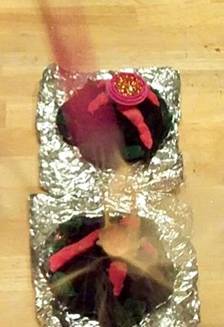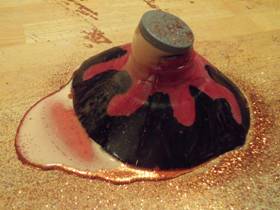These demonstrations are a twist on the classic homemade volcano, in which vinegar and baking soda chemically react in a model of a volcano to produce sodium acetate, water, and carbon dioxide gas. The carbon dioxide bubbles up out of the model to produce bubbling “lava” which oozes out of the “volcano”. The picture below shows the same reaction in a soda bottle (food coloring and dish soap have been added to make the lava flow more impressive).


But what about the volcanoes with more explosive eruptions? Here we adapt another classic demonstration involving film canisters and Alka-Seltzer tablets. Wear eye protection. First lay down a sheet of plastic to make cleanup easier. Place a film canister into a clay volcano, setting the lid aside for now. Fill a milk cap with glitter. Fill the film canister halfway with water, with maybe a little dish soap and red and yellow food coloring for a “lava” effect. Break a tablet of Alka-Seltzer in half (any more that is wasted). Make sure everything is ready and the area is cleared out around the volcano.

Then, QUICKLY add the half-tablet of Alka-Seltzer to the film canister, cover the canister tightly with the lid, place the milk cap full of glitter on top of the lid, and take a step back (NEVER stand over the lid). The citric acid and baking soda in the tablet dissolve in the water and chemically react to produce sodium citrate, water, and carbon dioxide gas. The gas pressure builds up in the capped film canister until the lid pops off, scattering the glitter and sending reddish suds oozing down the side of the volcano.

Then, QUICKLY add the half-tablet of Alka-Seltzer to the film canister, cover the canister tightly with the lid, place the milk cap full of glitter on top of the lid, and take a step back (NEVER stand over the lid). The citric acid and baking soda in the tablet dissolve in the water and chemically react to produce sodium citrate, water, and carbon dioxide gas. The gas pressure builds up in the capped film canister until the lid pops off, scattering the glitter and sending reddish suds oozing down the side of the volcano.


We can also use the Alka-Seltzer tablets to illustrate the effects that size has on processes. If the half-tablet that is added to the film canister is first broken into small pieces, it will dissolve much more quickly in water to react and produce carbon dioxide gas. The result is that, with all else equal, a popper volcano with the broken-up half-tablet will pop more quickly after loading than one with an intact half-tablet. This illustrates how processes can proceed more quickly at smaller scales. For example, many people are studying how making things really small (at the nanoscale) with lots of surface area can speed up chemical reactions.
Another note: We have also noticed that a film canister fits into the top of a milk jug with just a little widening (we also colored the jug piece with permanent markers). This seems to be very inexpensive way to make a waterproof volcano cone without having to use modeling clay.

No comments:
Post a Comment